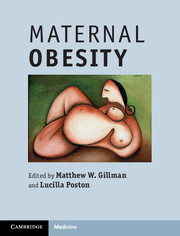Book contents
- Frontmatter
- Contents
- Contributors
- Preface
- Section 1 Trends and determinants of obesity in women of reproductive age
- Section 2 Pregnancy outcome
- Section 3 Long-term consequences
- 8 Long-term consequences of obesity in pregnancy for the mother
- 9 Long-term consequences of maternal obesity and gestational weight gain for offspring obesity and cardiovascular risk: intrauterine or shared familial mechanisms?
- 10 Influences of maternal obesity on the health of the offspring: a review of animal models
- 11 Developmental origins of obesity: energy balance pathways – appetite
- 12 Adipose tissue development and its potential contribution to later obesity
- 13 Maternal diet and nutritional status and risk of obesity in the child: the role of epigenetic mechanisms
- Section 4 Interventions
- Section 5 Management and policy
- Index
- Plate Section
- References
10 - Influences of maternal obesity on the health of the offspring: a review of animal models
from Section 3 - Long-term consequences
Published online by Cambridge University Press: 05 August 2012
- Frontmatter
- Contents
- Contributors
- Preface
- Section 1 Trends and determinants of obesity in women of reproductive age
- Section 2 Pregnancy outcome
- Section 3 Long-term consequences
- 8 Long-term consequences of obesity in pregnancy for the mother
- 9 Long-term consequences of maternal obesity and gestational weight gain for offspring obesity and cardiovascular risk: intrauterine or shared familial mechanisms?
- 10 Influences of maternal obesity on the health of the offspring: a review of animal models
- 11 Developmental origins of obesity: energy balance pathways – appetite
- 12 Adipose tissue development and its potential contribution to later obesity
- 13 Maternal diet and nutritional status and risk of obesity in the child: the role of epigenetic mechanisms
- Section 4 Interventions
- Section 5 Management and policy
- Index
- Plate Section
- References
Summary
Introduction
The prevalence of obesity among women worldwide (Figure 1.1; Chapter 1) is a cause for serious concern, not only for the mother’s health but also that of her children, whether a result of the immediate risk of complications in pregnancy or from more subtle influences on the developing child (Chapters 9, 11, 12, and 13). In this chapter we provide a summary of the role that animal models have played in contributing to our understanding of potential influences of maternal obesity on offspring health in later life.
As described in Chapter 9, many observational studies in mother/child cohorts have reported an independent association between maternal BMI and offspring BMI in childhood and adulthood [1,2], but the expected predominance of maternal obesity vs. paternal obesity in parent–child obesity relationships is not always apparent [3,4]. Alternative explanations for mother–child associations of obesity are that the child inherits obesogenic genes or that they share similar postnatal environments. There is also some suggestion that maternal obesity is associated with the risk of elevated blood pressure and cardiovascular disease in childhood and beyond, but this is limited to a few reports [5–8]. Intervention studies in obese women before or during pregnancy, with follow-up of the children, are likely to provide the strongest test of the hypothesis that obesity per se causes adverse offspring outcomes. Observational studies of siblings whose mothers achieved weight loss through bariatric surgery certainly provide some support; the sibling born to the mother before surgery is more at risk of obesity than the brother or sister born after maternal weight loss [9]. However, randomized controlled trials of interventions have yet to report and in the meantime the theory that obesity in the pregnant woman directly increases the risk of obesity and related disorders through influences on the unborn child remains to be proven.
- Type
- Chapter
- Information
- Maternal Obesity , pp. 100 - 114Publisher: Cambridge University PressPrint publication year: 2012
References
- 2
- Cited by

